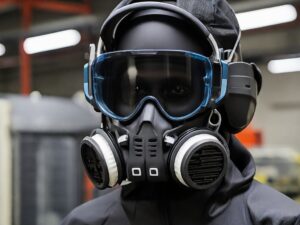At the onset of the COVID-19 pandemic, a critical shortage of PPE rang alarm bells across the health sectors worldwide. Masks, shields, gowns, and gloves were in dire demand, with traditional manufacturing unable to keep pace. It was during this crisis that 3D printing emerged as a beacon of hope. This additive manufacturing process, which layers materials to create objects from digital files, demonstrated an unparalleled capacity for rapid prototyping and production.
3D printing technology empowered hospitals, non-profit organizations, and even individuals to create PPE on-site, tailoring solutions to their immediate needs. For example, face shields, which are essential for protecting healthcare workers from airborne particles, could be produced quickly and cost-effectively, providing immediate relief during supply chain disruptions.
Advantages of 3D Printing in PPE Manufacturing

One of the advantages of 3D printing in PPE manufacture is the capability to customize products for specific users. Traditional one-size-fits-all equipment can lead to discomfort or even reduced efficacy. 3D printing allows for PPE that conforms perfectly to the wearer’s dimensions, enhancing comfort and safety.
Time is of the essence during health crises, and 3D printing’s rapid prototyping is unmatched. It can translate designs into functional products in a fraction of the time it takes traditional manufacturing methods, thereby saving lives through faster response rates.
With the flexibility of 3D design, modifications to existing PPE products can be made swiftly, allowing for innovative features that improve functionality and user comfort.
3D printing decentralizes production, making it possible to manufacture PPE locally. This has profound implications for logistics, as it reduces the dependency on global supply chains and mitigates shortages due to transportation delays or trade barriers.
Traditional manufacturing often results in significant material wastage. 3D printing can be much more resource-efficient, using only the necessary materials to create a product, which leads to less waste and, consequently, an environmentally friendlier process.
Challenges with 3D Printed PPE
Quality Assurance: each item must be produced to meet preset benchmarks that affirm its capability of acting as a sufficient barrier against hazards found in medical and high-risk environments. Unlike homogeneous mass production, 3D printed items can have slight differences due to printer calibration, ambient conditions, or model slicing software. To assure reliability, each print batch requires strict testing and validation processes which can be costly and time-consuming. Achieving medical-grade quality demands meticulous design and the integration of precise manufacturing standards, which are both essential to ensuring that the equipment performs reliably under the conditions it’s intended for.
Material Limitations: types of polymers and composites used for 3D printing are often less varied compared to those available in traditional manufacturing, leading to potential compromises in the durability, flexibility, and long-term wearability of PPE. Certain materials that are ideal for medical use, such as biocompatible silicones and latex, are not readily printable or do not have 3D printable equivalents with the same properties. The end products may not fully match the required standards for protective equipment, or they may need to undergo additional finishing processes, which can undermine the benefits of 3D printing in terms of speed and cost.
Scalability: 3D printing offers innovation in product design and customization, but it struggles to compete with the economies of scale that are part and parcel of conventional manufacturing, particularly for products as widely used as PPE. While suitable for creating prototypes and handling small production runs, 3D printing technologies typically do not support efficient upscaling to meet the demands of global crises, such as a pandemic, where the need for PPE can surge overnight. Transitioning from a model that handles dozens to one that handles thousands or millions of units necessitates a substantial number of printers, materials, and operational oversight, which might not be feasible or economically viable for many organizations.
Regulatory Hurdles: for PPE, compliance with health and safety regulations is non-negotiable. The benefits of rapid design iteration and production that 3D printing offers are often curtailed by the need for regulatory review and approval, which can lag notably behind the speed of technological advances. The iterative nature of 3D printing means that each design alteration, no matter how minor, might require a new round of certification, representing a substantial bottleneck in the production and deployment of 3D printed PPE. This is particularly problematic during emergent situations when equipment is urgently needed, yet cannot be deployed due to pending approvals.
While 3D printed PPE can be an innovative solution, especially in times of immediate need or specific customization requirements, these challenges must be addressed to fully harness the potential of 3D printing technologies within the PPE sector. A concerted effort from manufacturers, regulators, and the wider medical community is necessary to streamline the integration of 3D printed PPE into mainstream healthcare applications.
The Future of PPE Through 3D Printing
Looking to the future, the role of 3D printing in producing PPE looks promising, with ongoing research and technological improvements addressing existing limitations. Greater automation and advancements in 3D printing materials will likely increase the viability of this technology for mass production. Continuous collaboration between regulatory agencies, manufacturers, and the 3D printing community can streamline the certification process for 3D printed PPE, ensuring it meets the necessary safety standards.
The integration of smart technologies such as IoT sensors into 3D printed PPE is not far-fetched. Such innovations could alert wearers about the degradation of their protective gear or when a hazardous environment is detected, making protection both proactive and reactive.

